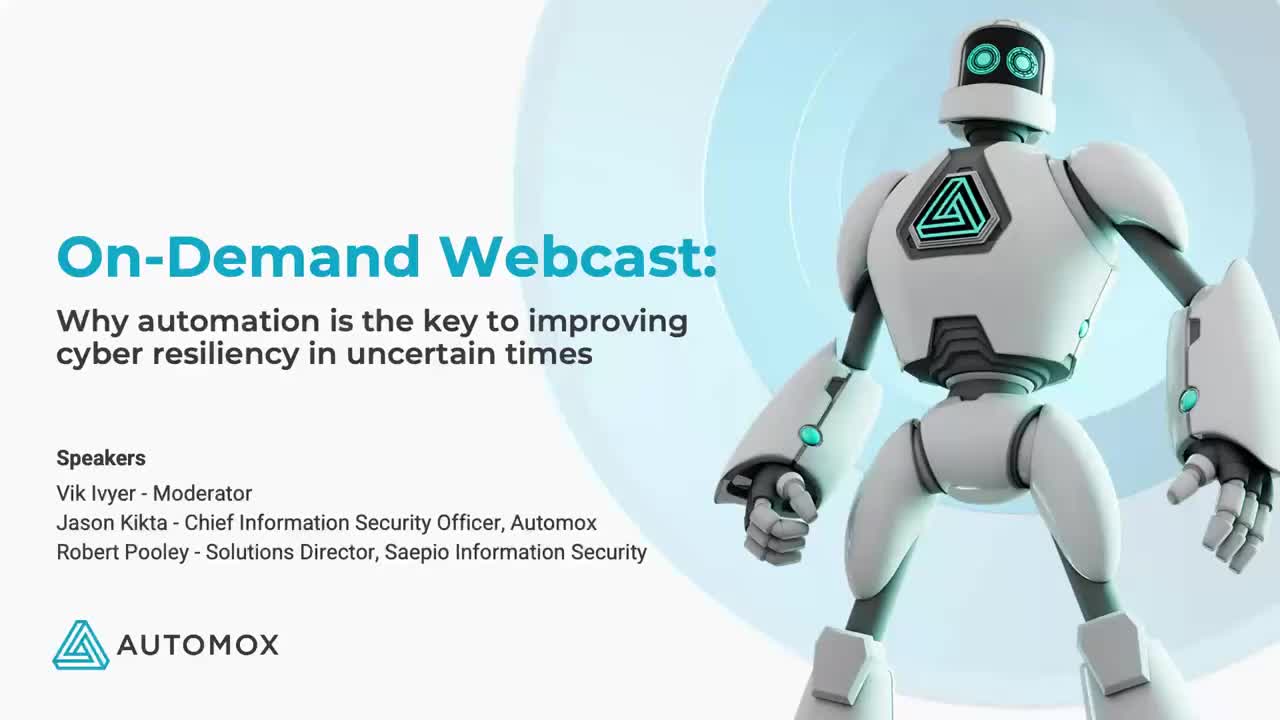Security teams can feel overwhelmed and disillusioned as they grapple with masses of alerts amid increasing threats from sophisticated cyber attackers. In particular, enterprises that reacted fast in response to global lockdowns need automation to help bolster their security efforts. But there are ways to calm the chaos.
In this webcast, Solutions Director and Co-Founder of Saepio, Robert Pooley, and Chief Information Security Officer at Automox, Jason Kikta, discuss why automation is the key to enhancing cyber resiliency today.
Why Automation is the Key to Improving Cyber Resiliency in Uncertain Times
Why Automation is the Key to Improving Cyber Resiliency in Uncertain Times

Click to watch the full interview now.
For a quick snippet of the interview read on:
According to Automox’s 2023 State of IT Operations Report, 55% of organizations use more than 6 tools to manage endpoints. How can tool sprawl affect organizations’ ability to automate?
“Sprawl is more of a problem for me in that there's too much that these tools generate in terms of work for operational teams to look after. And consolidation is a big thing in cybersecurity right now. It's grown organically over time, so [...] different tools have been acquired to deal with different things and we end up with masses of platforms that deal with similar tasks and they're overlapping and competing with each other. [...] Step one is consolidating those tools and getting a more manageable set of platforms. Then, you can start looking at automation.
I'd say the bigger issue around why people don't adopt automation is they see it being risky and it might break things. They've got existing manual processes and numerous tools they're kind of happy with, so why break it if it's not broken?
Then there's the cost of it. But there's a misconception about the cost of automation. There's a view that automating things is fancy technology and it's going to be really expensive and, perhaps, those needing to automate aren’t seeing how immensely thoughtful automation can benefit them.” – Robert Pooley, Solutions Director & Co-Founder of Saepio
90% of respondents to Foundry’s 2022 Security Priorities Study say their organization is falling short in terms of addressing cyber risk. Tell us more about the threat landscape right now.
“What’s changed in the threat landscape over the last five years, and certainly over the last decade, is really sort of the approach that a lot of threat actors are taking. Before what you would see was very limited criminal activity. Very simple things that were relatively easy to detect were pretty predictable. You’d see high-end bespoke tooling, extensive reconnaissance, extensive work to get into a network, and a lot of desire to not be caught.
Now, we've shifted to the commoditization of access, and what you're finding is that ransomware actors are buying access from whoever they can. Same thing with business email compromise. Criminals have a number of access brokers from whom they're purchasing access. So, you know, the initial access to your network is compromised, whether it be a phishing or taking advantage of unpatched systems.” – Jason Kikta, Chief Information Security Officer at Automox
Can you give us insights into how customers are reacting to this situation? Are businesses taking robust action or is there reluctance to invest in these difficult times?
“You can't bury your head in the sand here. It's talked about a lot and from our experience, we conduct a lot of cyber risk assessments using the NCES and that involves speaking to executives at various different organizations and they definitely have the desire to be cyber secure. The issue, though, is that the time, knowledge, and skills to achieve the right cybersecurity posture are the challenge. It's like the leadership team wants to click their fingers and be cyber secure and there's definitely a delta between the desire and the capability to achieve it.
The majority of organizations are investing in and maturing their cyber resilience. It's definitely a different jigsaw puzzle for each business, but the general theme we see at Saepio is an investment in cyber resilience rather than burying their heads in the sand. But it remains a challenge for most organizations to move cybersecurity beyond it being an IT challenge and into the realm of really being a business risk. The board must own that risk and inject the right resources and budgets to get into the right cybersecurity posture.” – Robert Pooley, Solutions Director & Co-Founder of Saepio
To hear more about how automation can solve your cyber resiliency pain points, check out the full webcast here.







)
)
)
)
